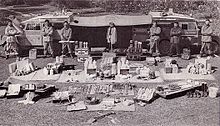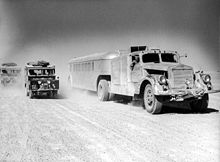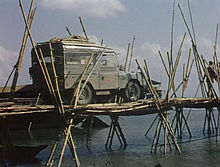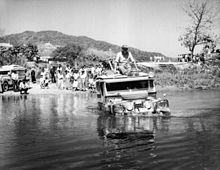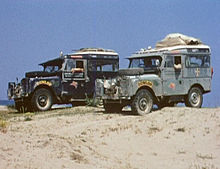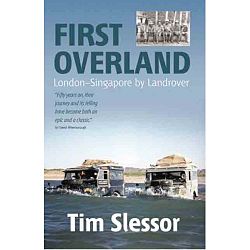- Oxford and Cambridge Far Eastern Expedition
-
The Oxford and Cambridge Far Eastern Expedition was a 1955 journey undertaken by six Oxford & Cambridge university students in two Land Rover Series I Station Wagons from London to Singapore and back. The expedition was primarily sponsored by Land Rover, who provided the vehicles, but was also sponsored by a total of more than 80 other third parties through both loaned and gifted equipment and supplies, ranging from whiskey to collapsible buckets, as well as monetary donations. The expedition was both filmed and documented, and the footage broadcast in the mid-50s on the BBC, which gave it the film in the first place at the behest of Sir David Attenborough. A book recounting the expedition, entitled First Overland, was written by Tim Slessor two years after the historic journey, and the expedition has been frequently referred to as the First Overland ever since. The expedition, its account, and the accompanying film footage are historically significant, as they not only recount the first such journey of this type by vehicle, but also provide the last recorded vehicular journey along the Ledo Road from India into Burma, as shortly afterwards the border between the two countries was closed.
Contents
The team
All of the expedition members were drawn from either Oxford University or Cambridge University, and all had just finished their degrees when they set out on the expedition, with the exception of Nigel Newbury, who had one year left, and who, incidentally was the only Oxford student. The expedition members and their roles on the expedition were as follows:
- Henry Nott - Chief Engineer
- Nigel Newbury - Quartermaster & Mechanic
- Adrian Cowell - Business Manager
- Patrick Murphy - Navigator & Chef
- Antony "B.B." Barrington-Brown - Cameraman
- Tim Slessor - Scribe & Assistant Cameraman
The vehicles
The two Land Rover Series I Station Wagons, one painted in Cambridge Blue (colour), the other in the darker shade of Oxford, were gifted to the expedition by Land Rover, and were straight off the production line. From Land Rover's point of view the expedition was both an extensive road-test, and a great publicity opportunity, for the vehicle before its 1956 commercial release. The new station wagons were very different to the previous 1949 wooden-framed Tickford model, being built with simple aluminium panels and bolt-together construction instead of the complex wooden structure of the older model. They were intended to be used both as commercial vehicles as people-carriers for transporting workmen to remote locations and for private use, but they were also advertised to the military of various countries along the route, and notably, in both the book and film, in Afghanistan. Like the Tickford version, they came with basic interior trim and equipment such as roof vents and interior lights. The vehicles taken on the expedition were also fitted with the station wagon "Safari Roof" which consisted of a second roof skin fitted on top of the vehicle. This kept the interior cool in hot weather and reduced condensation in cold weather. The expedition vehicles had the 86.0 in (2184 mm) steel wheelbase, produced between 1954 and 1956, and the larger 2.0 litre I4 unit engine, which had replaced the 1.6 litre version in 1952. Slight modifications to the two vehicles taken on the expedition included the addition of a front-mounted jerry can on either side of the grille, a spotlight on each vehicle, an additional 100 gallon petrol tank in the rear of each vehicle, and front mounted engine-driven winches.
The route
After setting off from Hyde Park in London, the expedition crossed the English channel in one of the air freighters of Silver City Airways; thereafter its route took it through France, Monaco, Germany, Austria, Jugoslavia (in areas now parts of Slovenia, Croatia and Macedonia), Greece, Turkey (crossing the Bosphorus by boat), Syria, Iraq, Iran, Afghanistan, Pakistan, India, Nepal, Burma, Thailand, Malaya and Singapore
This was the first time that this route, or one similar to it, had been attempted in its entirety by vehicle. It would be one of the longest of all overland journeys, from the English Channel to Singapore. Several expeditions had already tried, and some had even got as far as the deserts of Iran or the plains of India, but none had managed to traverse the jungle-clad mountains of Assam and cross northern Burma and Thailand to Malaya. Many elements of the route taken had previously been deemed as anything from highly risky in terms of the possibility of vehicles breaking down in isolated locations to being totally impassable up to that point. One such stretch of the journey was the desert run between Damascus and Baghdad, a gruelling fourteen and a half hour drive across largely virgin desert only for the adventurous or one of a handful of specialised vehicles, such as the Nairn Transport Company's two Marmon-Herrington 6x6 articulated buses. Another such stretch was the narrow mountain route into Nepal, where previously, for sections along the route, vehicles had hitherto been dismantled and carried over obstacles, but which the two Land Rovers drove. The other obvious example is of course the most famous stretch following the Ledo Road, constructed by General Stilwell of the U.S. Army during World War II, from Ledo in the Assam province in India through to the Mong-Yu junction with the Burma Road in North Burma. This section of road, which had largely fallen into disrepair following the War as an area controlled by head hunters and bandits, spanned 10 major rivers and 155 secondary streams, averaging one bridge every 2.8 miles (4.5 km). Each of these had to be pre-emptively checked and tested by the expedition members before any crossings were attempted, and, frequently, the vehicles had to chance it and ford the rivers. At one point in the journey, crossing the Brahmaputra river in India, it did become necessary for the Cambridge vehicle to pull the Oxford vehicle to safety using the vehicle's front mounted winch. In Northern Thailand there was also a stretch of 100 miles where no proper road had ever been constructed, and the expedition had to quite literally cut its way through the jungle.
The journey to Singapore took six months and six days, during which time the expedition had traversed 18,000 miles. They then enjoyed 3 weeks of rest and relaxation and a little fieldwork, before shipping one car back to Rangoon and one to Calcutta en route back to London. They arrived back in August 1956.
Aftermath
On the 50th Anniversary of the Expedition, the five surviving members (all except Henry Nott) traveled once more to the Far East and recreated the last leg of their journey, covering the 350 km from Kuala Lumpur to Singapore on 4 March 2006. The following day, the five men did the one thing they forgot in 1956 - they followed Rudyard Kipling's instruction to "feed at Raffles" and enjoyed brunch at the Bar and Billiard Room and Singapore Slings at the Long Bar.
The 1955 route as a whole is now deemed largely impassable, not least because of the wars in Iraq and Afghanistan, but also on account of the fact that the Indian border with Burma was closed in 1958 due to an insurgency along that frontier and in the province of Assam against the Government of India. The Oxford and Cambridge Far Eastern Expedition was the last recorded vehicular journey along the Ledo Road route from India into Burma. At present, the northern border of what is now Myanmar is open to local trade, but to this day it remains totally closed to foreigners, and the whole border is closed to any non-locals in vehicles.
First Overland
First Overland: London-Singapore by Land Rover is the 1957 book recounting the expedition by Tim Slessor, originally published by The Companion Book Club under the title First Overland: The Story of the Oxford and Cambridge Far Eastern Expedition. The 2005 50th anniversary edition, published by Signal Books Ltd also contains a foreword by Sir David Attenborough, who is listed as co-author. The book is the main source of information about the expedition and its fullest account, as the footage and subsequent programmes made with it only cover a small portion of what the six students did and experienced on their long journey.
“ one might reasonably claim that both the journey and its telling are now regarded as classics of their kind... ” — Extract from the foreword by Sir David Attenborough
Adaption for screen
The expedition set out with only a limited quantity of film from the BBC, but with the promise of more from Sir David Attenborough if the initial material sent back was good. In the end there was enough material for 3 short films for the BBC series 'Traveller's Tales' which were shot in colour, but only transmitted in black and white. In the late 50s there was no home recording technology like VHS, so once broadcast, the films faded from view and have only been seen occasionally since. Recently they have been re-mastered and edited, with a commentary by the cameraman Antony Barrington-Brown and Tim Slessor, and interviews with Nigel Newbery, Pat Murphy, Adrian Cowell and Sir David Attenborough. The DVD also has an 'extra' about the making of the original films and the rescuing of the footage.
Repeat attempt
A replication of the entire original journey is set to be attempted by First Overland 2010, another group of mainly Cambridge students. The preparation for this expedition has been under way for over two years, and two 1950s Land Rover Series I Station Wagons have been done up to almost exactly the same specifications as the original vehicles. The only planned alteration made to the route is that Iraq and Afghanistan are to be avoided. An additional aim of this planned expedition is to distribute a new model of adjustable glasses in India as part of a field test for the Centre for Vision in the Developing World, a project pioneered by its current director Joshua Silver.
References
- Slessor, Tim. (1957), First Overland: The Story of the Oxford and Cambridge Far Eastern Expedition, The Companion Book Club, London.
External links
Categories:- 1955 in transport
- 1957 books
- Clubs and societies of the University of Oxford
- Clubs and societies of the University of Cambridge
Wikimedia Foundation. 2010.

